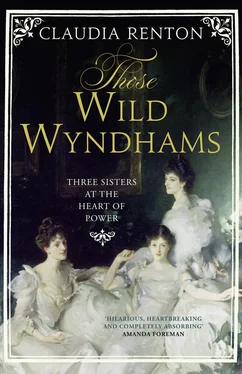Pamela in the flesh made the shortcomings of Pamela in oils all too clear. Sargent told Pamela in his deep, curiously accentless voice (the legacy of his Continental upbringing) that he ‘felt sure ’ that Mr Wyndham ‘would not mean it to be as it is’. ‘He is very anxious for some more sittings from me and enquired my plans most pertinaciously,’ Pamela told Percy the next day. Her very presence had seemed to prove an inspiration: ‘“and now I see you oh it must be worked on” – squirming & writhing in his evening suit – “no finish – no finish” – he got quite excited’. 6
As agreed, Pamela made her way to Sargent’s studio on Tite Street in Chelsea at half-past two the following Saturday. Three or four days was all that Sargent, a phenomenally fast worker, required before she could thankfully flee London once again. ‘He has not repainted the face … He worked on little corners of it and has much improved it I think,’ Pamela said. He had remodelled her nose, taken ‘a little of the colour out of my cheeks, this improves it’, and transformed her hair from ‘all fluffy and rather trivial looking before’ to swept back, which ‘has strengthened it, and made it more like my head really’.
There was one loss. The front of Pamela’s dress, an eye-catching blue, had, Sargent said decisively, to go. It was, she explained to her parents, ‘disturbing to the scheme … And much as I regret my pretty blue front I quite see it was rather preclusive of other things in the picture as a whole. For instance both sisters seem to gain by its removal – one’s eye is not checked & held by it … My face also seems to gain significance by its removal.’ 7Mary, who had always been suspicious of Pamela’s colour choice, must have been relieved: ‘blue can be so ugly don’t you think?’ she had complained to their mother when Pamela had first announced her sartorial intentions. 8
Uncharacteristically, Madeline was causing trouble. At the Ribblesdales’, Sargent had been adamant that ‘Mrs Adeane in particular’ needed to be changed, requiring a further week of sittings. The year before, Charlie Adeane’s patience with ‘that blessed picture’ had worn thin when Madeline had caught influenza while sitting for it. Now, with Madeline still recovering from her infant son’s death, Charlie Adeane, as protective as he was devoted, might prove the spanner in the works. ‘I hope you will use your influence if Charlie is against it,’ Pamela implored her father; ‘it seems a pity if it is so near it shouldn’t be managed.’ 9Madeline Wyndham, who could never refuse anything to her ‘Benjamina’, as she called her youngest daughter, replied, ‘I think it would amuse her – & I should trust it was warmer in Sargent’s Studio than it is in [the] large drawing room at 44 this time of year without hot water or hot air which I am sure Sargent’s studio has … you ought write to Madeline & beg her to go up for a week she can be snug as a bug in my bedroom and she & Charlie can be there.’ 10
In art, as in life, Mary was proving difficult to pin down. Marooned among the rugs, tapestries and antiques that formed the paraphernalia of an artist’s studio, 11as Sargent, muttering unintelligibly under his breath, charged to and from the easel (placed, as always, next to his sitters so that when he stood back he might view portrait and person in the same light), 12Pamela had to exercise all her diplomatic skill when asked what she thought of Sargent’s depiction of Mary. ‘I could say honestly I liked it,’ she told her parents, ‘but I did not think it “contemplative” enough in expression for her.’ And ‘no sooner than I had said the word “contemplative” than he caught at it. “Dreamy – I must make it a little more dreamy!”’ All it needed, apparently, was a touch to Mary’s hooded eyelids, which Pamela agreed were ‘a most characteristic feature of her face’; but ‘of course he will not do it till she sits to him’, she concluded, with not a little exasperation. 13
Astonishingly Mary – nicknamed ‘Napoleon’ by her friends for her tendency to make monumental plans that rarely came to pass, and who seemed, in the view of her dear friend Arthur Balfour, ‘to combine into one disastrous whole all that there is of fatiguing in the occupations of mother, a woman of fashion, and a sick nurse’ 14– got herself to London, and to Tite Street, in time for the painting to be completed so that it could be displayed at the Royal Academy’s Summer Exhibition that year.
The Wyndham Sisters , to the gratification of all (and doubtless Pamela in particular) was heralded as Sargent’s masterpiece. For The Times , it was simply ‘the greatest picture which has appeared for many years on the walls of the Royal Academy’. Bertie, the elderly Prince of Wales, who had honed his eye for beauty over many years, dubbed the portrait ‘The Three Graces’.
It was, crowed the Saturday Review , ‘one of those truces in the fight where beauty has unquestionably slipped in’. 15Though we now think of Sargent as the Annie Leibovitz of his day – intently flattering at all costs – at that time people did not see it in quite the same way. ‘In all the history of painting’, commented the critic D. S. MacColl in the Saturday Review in 1898, ‘hostile observation has never been pushed so far as by Mr. Sargent. I do not mean stupid deforming spite, humorous caricature, or diabolic possession … rather a cold accusing eye bent on the world.’ MacColl likened Sargent to ‘the prosecuting lawyer or denouncing critics’. His work made the viewer ‘first repelled by its contempt, then fascinated by its life’. 16‘I chronicle,’ declared Sargent, ‘I do not judge.’ 17The dazzling results seduced the aristocracy, but they commissioned him with trepidation. ‘It is positively dangerous to sit to Sargent,’ declared one apprehensive society matron; ‘it’s taking your face in your hands.’ 18
One oft-repeated criticism, that Sargent did no more than replicate his sitters’ glamour, is perhaps a misunderstanding of the emptiness that his brush was so often revealing. To defeat any accusation that The Wyndham Sisters is simply a pretty picture, one needs only to look at the sisters’ hands. Pamela’s fingers imperiously flick outwards as she lounges back on the sofa, in the most obviously central position as always, unblinkingly staring the viewer down; Mary’s thin hands worry at each other as she perches on the edge of the sofa and gazes ‘dreamily’ off into the distance showing all her ‘delicate intellectual beauty’. Then there is Madeline, who uses her left hand to support herself against the sofa, while her right hand, quelled by sorrow, lies in her lap, patiently facing upwards, cupped to receive the blessings that fate, in recent months, had so conspicuously denied her. Underneath the serenity is the wildness of the Wyndhams, the foreign strain from their mother’s French-Irish blood, that people would remark on time and time again.
Before the sittings began, before the composition had been decided upon, Madeline and Percy Wyndham had arranged a dinner at Belgrave Square for Sargent to meet his sitters properly. Watching the family at home, Sargent had caught on immediately. Rather than paint these women in his studio, as was the norm, he set them in the drawing room of their parents’ house. As one’s eye becomes accustomed to the cool gloom behind the seated figures swathed in layers of white organza, taffeta, tulle, one can make out in the background the portrait of their mother that hung in that room: George Frederic Watts’s portrait of Madeline Wyndham, resplendent in a sunflower-splashed gown, that had caused such a stir at the Grosvenor Gallery a quarter of a century before. Through the darkness, behind Mary, Madeline and Pamela, gleams Madeline Wyndham. So in art, as in life. Sargent had not missed a thing.
Читать дальше












